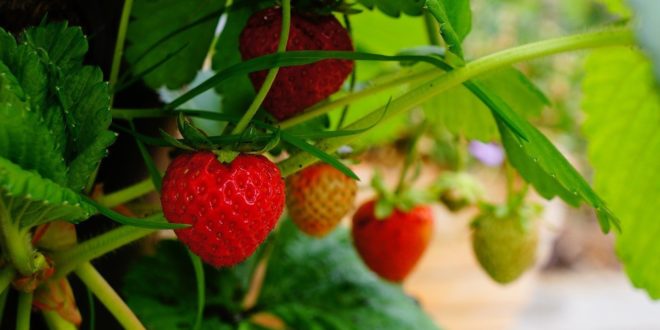Berries are among the most anticipated summer fruits – so why is it that gardeners are, more often than not, disappointed by them? The answer is three-fold: poor pruning, inadequate feeding, and insufficient watering. Unless you live in one of the very coldest parts of the country (think ‘mountainous regions of central North Island’, or ‘inland Otago and Canterbury’), there’s not much you can do to mitigate the first problem (poor pruning). However, what you do from now on, with feeding and watering, can make all the difference to your harvest.
Strawberries
One of the most coveted soft fruits is the strawberry – but not just any strawberry! We don’t want them woody, small, sour, or tasteless. Moderately-sized, soft, and deliciously-sweet is the aim – and feeding and watering will help.
Whether you are growing your strawberries in a ‘strawberry tree’ (a tall container with ‘side pockets’ moulded into it to hold the plants) or directly into the ground (usually on ridges to assist with drainage), there’s a real danger of under-watering and over-watering. To test if the strawberry plants require water, gently insert a finger, up the second knuckle, into the soil around the roots. If your finger comes out with some fragments of soil adhering to it, don’t water. If it comes out clean, it’s time to add moisture.
If you have used artificial fertilizers in your growing mix or soil, you will also want to ensure a potentially harmful build up of chemical salts doesn’t occur. To avoid this, heavily water the plants (on a warm, dry day) once a fortnight. This heavy watering helps flush the fertilizer residue away from the root zone. Better still, skip the artificial fertilizer, and prepare the bed or pot using compost and well-rotted animal manure or manure pellets.
Regardless of whether you are using chemical or natural fertilizer, nothing beats a weekly liquid feed of seaweed extract (you can buy this at garden centres or brew your own by soaking seaweed in a bucket of water for a couple of weeks). Seaweed is rich in potassium which strawberry plants love.
Lastly, encourage foliage and root growth, in this early part of the season, rather than flowers. To do this, pinch out the first two flowers produced on each plant.
Perennial berries
Most other berries in the garden are regarded as perennials (plants that remain in the ground, and which are pruned in winter or autumn, ready to regrow the following year). These include raspberries, gooseberries, Worcester berries, currants, blue berries, hybrids and other cane berries.
To produce heavily over summer, these plants require feeding, preferably from early spring onward. Feed them with lashings of compost, well-rotted animal manure or manure pellets, chopped sea weed, and a scattering of non-toxic wood ash from paint-free, untreated-wood. Be sure to spread these nutrient-rich materials right out to the ‘drip line’ (the outermost circumference of the branches).
Top this feed with a deep mulch of pine needles or pea straw. In cool regions, apply the mulch only once the days start to warm up. Put it on any sooner, and the soil will be slow to warm. As the season progresses, feed perennial berries weekly with liquid seaweed manure (see above). Seaweed promotes healthy flowering. Don’t be tempted to add any animal manure to the liquid feed, as this will be nitrogen-based, and nitrogen encourages leaf growth at the expense of flowers and fruit.
Adequate watering is essential, especially once fruit begins to form. Apply the finger test (see above), and never drown the roots to the point of waterlogging the ground, or they won’t be able to ‘breathe’ and support the plant.
Easy-peasy
Berry care isn’t difficult, but attend to it regularly and you will be rewarded with heavy crops of plump, succulent fruit. Here’s wishing you a berry happy soft-fruit season in the garden!










Join the Discussion
Type out your comment here:
You must be logged in to post a comment.